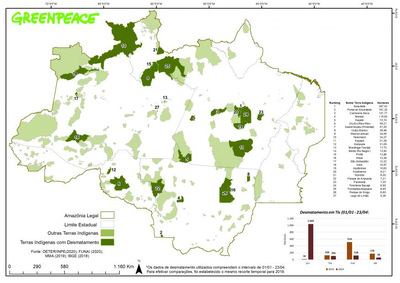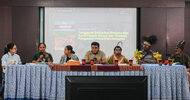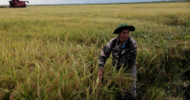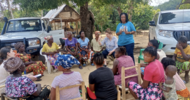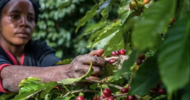Greenpeace | 11 May 2020
Brazil: Deforestation on indigenous lands increases 59% in the first months of 2020
May 11, 2020 – Deforestation and Covid-19 are advancing on the forest and the people who live in it and with overwhelming speed and catastrophic predictions. An analysis of data from the Deter system, from the National Institute for Space Research (Inpe), shows that in the first four months of 2020, warnings of deforestation in indigenous lands in the Brazilian Amazon increased by 59%, compared to the same period last year . This is the highest index in the past four years . This means that 1,319 hectares of forest – equivalent to 1,800 football fields – were deforested within indigenous territories from January to April 2020. In the same period last year, this number was 827 hectares.
The map below shows the most deforested indigenous lands in Brazil between January and April 2020:
These data reinforce the warning that loggers, grileiros and prospectors do not make a home office and, worse, these invasions can be the gateway for the coronavirus to reach indigenous communities.
Contrary to the search for solutions, the government, which, until now, has not taken effective actions to protect indigenous peoples or Brazilian forests, further weakens environmental inspection , with the dismissal of professionals from the Brazilian Institute for the Environment and Renewable Natural Resources (Ibama), responsible for recent and important operations against illegal miners and loggers in the Amazon.
In addition, it encourages the invasion of indigenous lands still in the process of demarcation, through Normative Instruction 09 of the National Indian Foundation (Funai) and Provisional Measure (MP) 910/2019, better known as “ MP da Grilagem ” – which promises the regularization of public lands that were invaded until 2018. As this MP “expires” on May 19, the federal government has acted ostensibly to force its vote in Congress as soon as possible.
“We are witnessing the pandemic spreading across the Amazon very quickly, which may, in fact, cause a new indigenous genocide. Meanwhile, the government turns a blind eye to the crimes that are increasing in the forest. This is unacceptable! We need to act – with the urgency that is necessary – to take care of those who take care of the forest. Given the absence of the State, we will continue to monitor and denounce, together with the indigenous movement and other partners, the activities that endanger the health and territories of the inhabitants of this country, ”says Carolina Marçal, of the Amazon campaign of Greenpeace Brazil.
Increase in deforestation is widespread
Deter’s warnings point to the tendency of an explosive increase in deforestation in recent months across the Amazon , meaning that destruction is not limited to indigenous lands only. April registered 24.2% more alerts than the previous month. Between January and April this year alone, the increase in deforestation alerts is almost 55.5% compared to the same period in 2019. It is worth noting that this period is rainy, which usually reduces the momentum of forest destroyers.
It is also shocking that the warnings point to a 172% increase in deforestation in Conservation Units in the first months of this year.
If we analyze the Deter data for the period from August 2019 to April 2020, the alerts point to an area deforested of 5,483 km². “This is the highest rate in the last five years and 99% higher than that recorded last year in the same period. If the alerts are confirmed by Prodes, which is the official rate of deforestation in the Amazon, which uses deforestation between August of one year and July of next year as a basis, we will have, unfortunately, another year of a sad record ”, says Rômulo Batista, who is also part of the Amazon campaign of Greenpeace Brasil.
Solidarity also spreads
Covid-19, unfortunately, reached the indigenous peoples, guardians par excellence of the forest, without which it will not be possible to overcome the other emergency that threatens humanity – the climatic one. It is public knowledge that indigenous peoples are historically more vulnerable to respiratory diseases. But in addition, they have several other vulnerabilities, such as social ones – many communities lack basic elements, such as soap and water – aggravated by the severe fragility of the structure of the health system that serves the indigenous people.
Since the first confirmed case in the indigenous population, in a woman of the Kokama people on April 1 , there are already at least 170 indigenous people infected with the disease and 38 deaths , according to the Articulation of Indigenous Peoples of Brazil (Apib). The Yanomami Indigenous Land, where a young indigenous man died on April 9, remains invaded by at least 20,000 gold miners, according to the Yanomami. They continue to move freely within the ancestral territory.
In view of this serious situation, solidarity actions have been implemented by several organizations. A team of Greenpeace employees, volunteers and activists has been making fabric masks for the most vulnerable communities, especially indigenous peoples. At first, the proposal of the initiative “Sewing to Aggregate” is to manufacture 15 thousand units. “It is actions like these that can effectively contribute to making a dynamic network possible, involving several actors, in a joint effort to interfere in this overwhelming dissemination of Covid among the indigenous populations of the Amazon”, explains Carolina Marçal.
Since the beginning of the outbreak, the indigenous movement has been active in alerting people about the need to protect and collaborate in very specific aspects of their realities. In this sense, the Coordination of Indigenous Organizations in the Brazilian Amazon (Coiab) has developed an emergency plan that has as one of the main objectives to guarantee food security in some regions.
Calls for the Brazilian State to fulfill its constitutional duty to protect indigenous peoples and their territories are beginning to emerge in the four corners of the world, in some cases involving personalities, intellectuals and politicians. The manifesto launched by photographer Sebastião Salgado for the protection of indigenous peoples against Covid-19 is an example. In addition to these initiatives, the letter sent to the director general of the World Health Organization (WHO), Tedros Adhanom Ghebreyesus, signed by almost 200 organizations and parliamentarians, among others, requesting specific measures to guarantee the protection of the lives of indigenous peoples in the world. Brazil.


